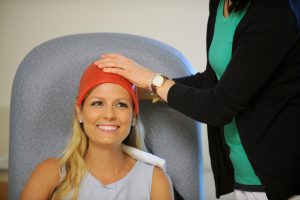
Hair defines who we are. The cut speaks to our personality. The texture hints at our ethnic background. The color, when natural, can point to our age. Hair is also the ultimate accessory, allowing us to accentuate features, minimize flaws and transform into anyone we want to be. As my dear friend and celebrity hair stylist, Ted Gibson, says, “Hair changes everything.”
So, it shouldn’t come as any surprise that one of the first questions oncologists hear from patients after being diagnosed is, “Will I lose my hair?” I can relate, as it was the first questions I asked. The thought of losing my long brown wavy locks was overwhelming, scary and sad. Who would I be without my hair?
For many women, maintaining their mane during cancer treatment is a priority. For some, it’s about privacy in the workplace. For other’s it’s about having sense of control. For other’s it’s about protecting their children from a horrible truth. Fortunately, many patients who wish to keep their hair can, thanks to cold cap therapy.
While cold cap therapy is getting more popular by the day, there is still a lot of mystery and misinformation surrounding this treatment. For example, I assumed a patient wore a cap only during each chemo treatment. But, alas, I was wrong. It was only after researching and interviewing patients about the therapy that I realized how time-consuming and exacting it is.
If you are considering doing cold cap therapy, below is a quick Q + A that provides a basic breakdown of what you’ll need to know going in:
What is Cold Cap Therapy?
Cold Cap Therapy is a hair-saving treatment that uses snug, gel-filled hats, chilled to –15 to –45 degrees Fahrenheit, to help constrict the blood vessels, limiting the amount of chemotherapy that reaches the scalp. It is believed that the cold temps help reduce the metabolic activity of the follicular cells, reducing the effectiveness of the chemo on the hair allowing it to remain in place.
How Does Cold Cap Therapy Work?
The caps, which vary in design from company to company, resemble a combination of an ice pack and a swim cap. In order to maintain a consistent, cold temperature, four caps are stored in portable medical coolers over dry ice and patients are required to rotate caps every twenty to thirty minutes.




(Photos courtesy of DigniCap)
How Long Does it Take?
Cold capping is a huge time commitment. One patient I interviewed for my book Pretty Sick: The Beauty Guide for Women With Cancer told me there were days when she had to wear her cap for up to 13 hours! The reason why is that the caps need to be worn for up to an hour prior to chemotherapy, during the chemo infusion (which can last up to six hours), and then for four plus hours post-infusion. It’s a real commitment.
Is Cold Cap Therapy Painful?
That depends on your tolerance to cold temperatures. Some patients/survivors I talked to told me they would get bad freezer burn headaches that lasted throughout the treatment and that the caps left ice chips in their hair. The treatment also makes the entire body cold, so patients are advised to keep warm by wearing heavy sweaters, extra layers of socks and by wrapping themselves in an electric blanket. One great tip I learned was to apply Dr. Scholl’s moleskin or panty liners on the forehead and around the ears to prevent freezer burn on the skin.
What Is the Cost?
Patients can hire trained “cappers” whose will tote the coolers and ensure rotation and application of the caps is done properly and efficiently. But this comes at a price. Typically, cold cap rental costs roughly $600 per day. “Cappers” cost an additional $350 to $750 daily. Most insurance companies DO NOT cover the cost of this therapy. In 2015, a cold cap system, DigniCap, was cleared by the FDA, so there is hope that in the future insurance companies will pay for or offer partial reimbursement but for now it’s an out-of-pocket expense.
What Companies Offer Cold Cap Therapy?
There are four companies in the United States. I have listed their names and websites below:
DigniCap
Penguin Cold Caps
https://penguincoldcaps.com/us/
Chemo Cold Caps
Arctic Cold Caps
Got any questions about cold cap therapy or any other cancer-related beauty question? I’d love to hear from you!
XO
Cait
…Hello again! If you got all the way down here, then I’m assuming you liked what you read. Good news! There’s more where that came from – including snippets of Pretty Sick: The Beauty Guide for Women with Cancer and news relevant to us Cancer Cuties. Go visit and (like!) the Pretty Sick Book FB page! https://www.facebook.com/prettysickbook/?ref=aymt_homepage_panel
Pretty Sick is out September 19th, but you can order your copy now! Just click below on the retailer of your choice!
Amazon
Barnes & Noble
IndieBound
iBooks



